The Garrison Cap, also called Side Cap or Overseas
Cap, has been around in the US Army since World War 1. The idea came from
the French 'Calot' Cap, being a more desirable piece of headwear then the
M-1911 Field Hat. It seems the Garrison kind of Cap was an European thing
in the beginning, being also used by The British, Italian and German army's
in one way or the other.
US Quartermasters Corps came up with a type of Cap that was referred to as
the Overseas Cap and was only worn by US Troops, not based in the US.
During the 1930's a small braid of fabric was added to the top folds of the
Garrison Cap, called 'piping'. Piping was only allowed for officers, not for
the regular Enlisted Men, and indicated one's particular branch within the
service.
The WW1 type Garrison Cap was an OD (Olive Drab) Cap which was deeper than the WW2 version, and had a small iron ring stitched into the front side so insignia could be worn without pressing through the Cap itself. The fabric itself was a coarse-woven material.
The WW2 Garrison Caps can be divided in 2 groups:
the OD Winter Caps or the lighter Khaki Summer Cap.
Some say OD was only for officers, but there are so many examples of Enlisted
Men pictured with OD Caps I really doubt the OD caps (with or without Piping)
were reserved for Officers and/or NCO's.
The USMC troops had their own specific forest-green
version in a slightly different texture.
WAC troops (Women's Army Corps) had their own, more rounded version of the
Summer and Winter Cap as did the WAAC troops (Women Auxiliary Army Corps).
In WW2 piping, also referred to as braids or cords, was allowed for both Officers and Enlisted Men.
Can you identify the 8 Garrison Caps in these two pictures by using the table below ?
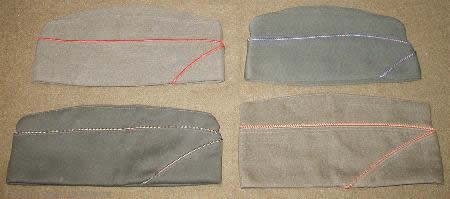
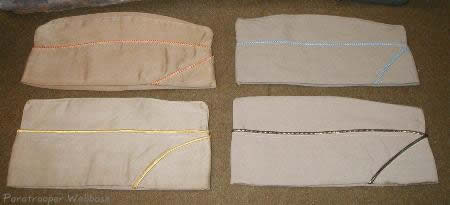
| Airforce | Ultramarine and Golden Orange Piping |
| Armored Forces | Green and White Piping |
| Army Specialist Corps | Burgundy and Grey Piping |
| Artillery Field (incl. PFAB - GFAB and Coastal) | Red or Scarlet Piping |
| Cavalry | Yellow Piping |
| Chaplains | Black Piping |
| Chemical Warfare | Cobalt Blue and Golden Yellow Piping |
| Detached EM | Green Piping |
| Engineers Corps | Scarlet and White Piping |
| General Officers | Gold Piping |
| Infantry (incl. PIR and GIR) | Light Blue Piping |
| Intelligence | Golden Yellow and Purple Piping |
| Junior Officers | Silver and Black Piping |
| Medical | Maroon (Brownish) and White Piping |
| Military Police | Yellow and Green Piping |
| National Guard | Dark Blue Piping |
| Ordnance | Crimson and Yellow Piping |
| QMC Quartermaster | Buff Piping |
| SC Signal Corps | Orange and White Piping |
| Staff Officers | Gold and Black Piping |
| TD Tank Destroyer | Golden Orange and Black Piping |
| Transportation | Brick Red and Golden Yellow Piping |
| Warrant Officer | Brown Piping |
| WAC Womens Army Corps | Old Gold and Moss Green Piping |
In case of the Airborne Troops Patches were worn on the front side of the Garrison Cap. Worn on the left side indicated Enlisted Men, worn on the right side indicated Officers. The Officers could wear their rank insignia (i.a. Lt Bars) on the left side of the Cap. Generally this goes for the first type of Parachute or Glider Infantry or Artillery Patches, only displaying a Parachute or Glider on a Blue (Infantry), Brownish (Medical) or Red (Artillery) background.
The later combined Airborne Patches (with a Glider
and Parachute displayed on a Dark Blue background encircled by a White, Light
Blue or Red border), can been seen worn on both sides of the cap.
Generally the point in which the front of the Glider is directed indicated
the difference between an Enlisted Men or an Officer. Glider pointed to the
Left: Enlisted Men. Glider Pointed to the Right: Officer.
The 3 pictures below show two Garrison Caps that were used during Market Garden. They both carry the Combined Airborne Patch with both the Glider and the Parachute. (See Close Up of this patch).

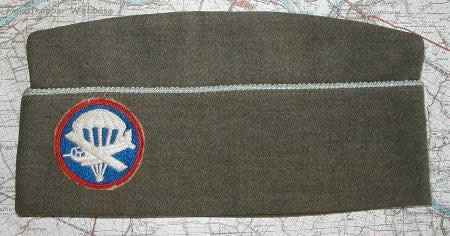
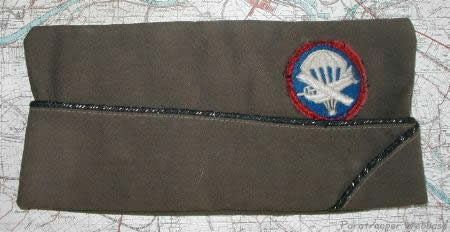
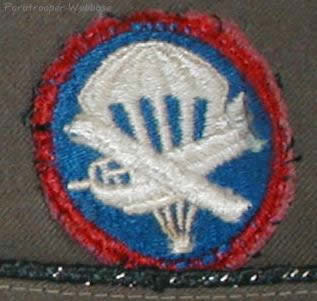
Article: D.C. van den Bogert
Sources:
- US National Archives
- 'Doughboy to GI' by Kenneth Lewis, ISBN 0-9521523-1-2
- 'The Way we Were: E-Co 506th PIR 101st AB. Cpl. Forrest Guth' by
Michel De Trez
- Collection Clements